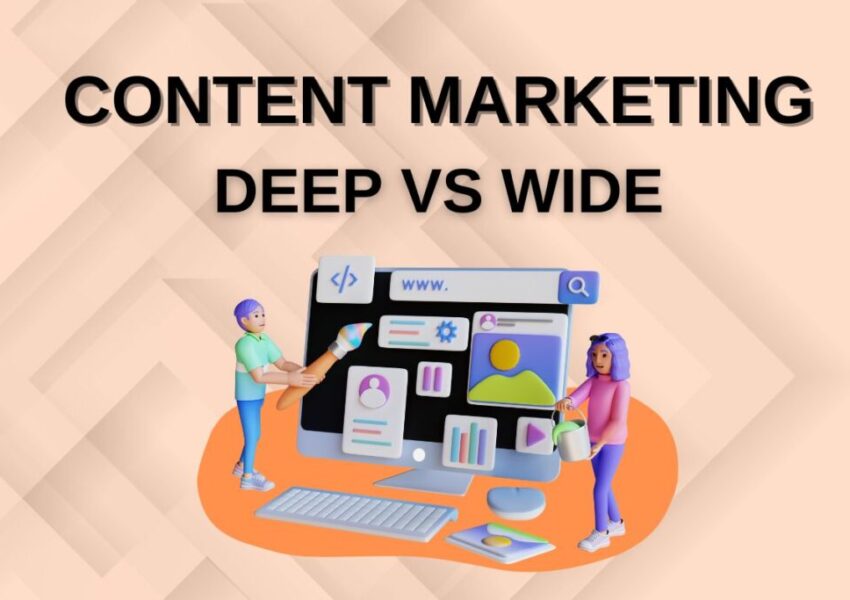Wide Vs. Deep Content Marketing: Which Is Right For You?

Published March 11, 2024
In the intricate realm of content marketing, deep content, and wide content stand out as two notable elements to consider. As you embark on this journey, a crucial question emerges: which will lead your brand to success?
In this article, we’ll look closer into the nuances of deep and wide content marketing. Let’s unravel their intricacies to help you chart a course that aligns with your goals and audience.
Defining The Difference: Deep Content Vs. Wide Content
Deep content is detailed and specific. It aims to offer thorough insights into a subject. This involves presenting in-depth articles, guides, or white papers on niche topics. Such content is strategically created to establish authority and enhance credibility.
Conversely, wide content or shallow content marketing covers a variety of subjects superficially. It tends to be shorter and more general. It’s crafted to appeal to a broader audience.

Benefits Of Deep Content
Deep content includes comprehensive, well-researched, and detailed material. It offers an in-depth insight into a subject. Here are the key advantages:
- Enhanced SEO. Search engines, such as Google, focus on high-quality, detailed content. Deep content often achieves higher rankings in search results, boosting visibility and traffic.
- Established authority. Crafting content makes you an expert in your field. Trust and credibility can be achieved by nurturing a positive relationship.
- Enhanced reader engagement. The content is inherently more captivating as it delivers substantial value to readers. This can increase time spent on your site and encourage social sharing.
- Increased backlinks. Sites are more likely to link to your content when it’s comprehensive and valuable. These backlinks can enhance your site’s search engine optimization (SEO).
- Boosted conversion rates. Deep content can answer reader questions well. It can lead to higher conversion rates.
- Long-term relevance. The content remains pertinent for a long time, unlike superficial, quickly outdated content. It delivers enduring value.
Creating deep content requires time, dedication, thorough research, planning, and thoughtful execution. The benefits like improved SEO, authority, and engagement justify the effort.

Benefits Of Wide Content
Wide content encompasses diverse topics, offering ease of consumption and creation. Here are the key advantages of wide content:
- Broad audience reach. Wide content caters to a varied audience by addressing multiple subjects.
- Enhanced brand visibility. Creating wide content can expand your audience base. It boosts brand recognition and may increase sales.
- Suitable for initial customer engagement. Wide content is particularly effective for engaging high-funnel customers exploring different options.
- Simplicity in creation and consumption. Wide content is quick to generate and more straightforward for readers to grasp.
- Promotes diverse reading. Reading widely exposes people to many texts. This helps them understand many subjects well.
- Showcases products and services. Wide content serves as a platform to showcase a range of offerings, enhancing marketing outcomes.
- Attracts unexpected customer segments. The broad appeal of wide content can draw unforeseen customers to your business.
Maintaining a balanced content strategy that incorporates both deep and wide content is essential. Deep content shows expertise and offers insights. Wide content reaches a broader, varied audience.
Challenges Of Deep And Wide Content Marketing
Deep and wide content marketing each presents distinct challenges. They address various parts of a content strategy. These challenges typically revolve around crafting, disseminating, and evaluating such content.

Deep Content Marketing
- Producing high-quality content. Developing deep content demands excessive research and subject expertise. It poses a consistent challenge in maintaining top-notch quality.
- Time and resource intensive. In most cases, creating this type of content consumes significant time and resources. Sadly, this is challenging for resource-constrained businesses.
- Potential for lower engagement. While valuable, the detailed nature of deep content may not resonate with all consumers. Doing so results in a drop in engagement rates.
Wide Content Marketing
- Maintaining relevance. Wide content spans various topics. It makes it challenging to uphold relevance and engagement for the intended audience.
- Lack of depth. Wide content inherently lacks the depth sought by some readers. Sadly, this can impact the perceived authority and expertise of your brand.
- Content overload. The breadth of wide content poses the risk of overwhelming your audience with excessive information. This leads to a decline in engagement levels.

Key Strategies For Deep And Wide Content Marketing Success
Both deep and wide content marketing offers distinct advantages. Combining both can lead to a well-rounded and comprehensive content strategy. Here are critical strategies for success to keep in mind:
- Define your objectives. Clearly stating your content marketing goals is the first step. It’s crucial for crafting effective content. It may involve looking into a topic or covering a broader spectrum.
- Know your target audience. You need a full understanding of your audience. It’s vital for making content that truly resonates with them. The principle holds for both deep and wide content.
- Measure success with analytics. Choose key performance indicators (KPIs). These include traffic, engagement, lead generation, and conversion rates. Doing so allows you to evaluate the effectiveness of your content strategy.
- Provide value and build trust. Always offering valuable content, whether deep or wide, makes your brand a thought leader. It also fosters trust with your audience.
- Find unique angles. To ensure highly successful content for your audience, find a unique perspective and explore it well. Cover the depth and breadth of topics that address your audience’s queries.
- Don’t sell, engage. Encourage audience interaction with your content by providing reasons to engage. Avoid overt selling and focus on delivering information or solving issues.
Remember, the choice between deep and wide content isn’t always black and white. The most effective content marketing strategies often blend both approaches. It entails customization to your brand’s objectives and your audience’s preferences.

Discover The Ideal Content Marketing For Your Brand
Choose between deep and wide content marketing. Pick the blend that fits your business goals, audience, and resources. Deep content offers authority and SEO benefits. Wide content reaches a broader audience and boosts brand awareness. If you want to excel in content marketing, merge the strengths of both strategies. Doing so can elevate your brand and engage your audience effectively.
Now, armed with these insights, create a content strategy. It should be compelling and connect with your audience. It should capture their attention and drive action.
Hire The Digital Marketing Experts
We take online businesses and turn them into online empires by employing smart digital marketing strategies. Our team of experts are trained in a myriad of marketing skill including SEO to help you rank higher in search results, and ad management to ensure your message gets seen by the people you want. Need a business website that attracts business? We also specialize in website design and online sales optimization to help your business grow like never before.

This Content Has Been Reviewed For Accuracy By Experts
Our internal team of experts has fact-checked this content. Learn more about the editorial standard for our website here.

About The Author
Hi, I’m Corinne Grace! As an experienced writer holding a bachelor’s degree from Riverside College, I excel in creating articles supported by thorough research. Specializing in a wide range of topics like marketing and law, I craft engaging stories that connect with my readers. I continuously work to refine my skills to adapt to the ever-changing digital world.



